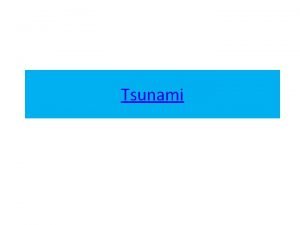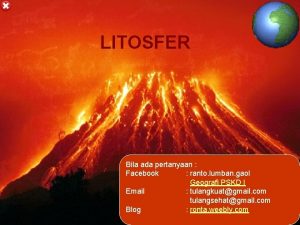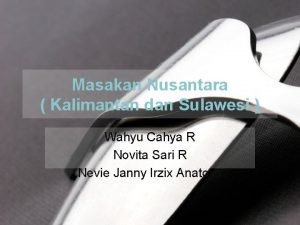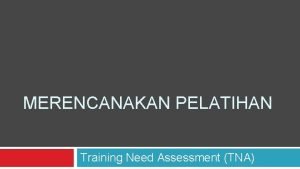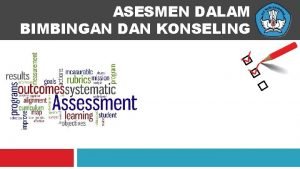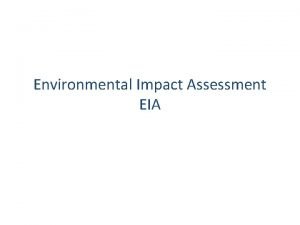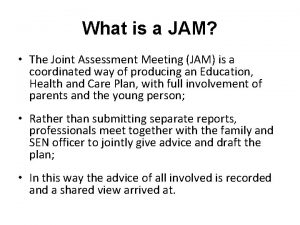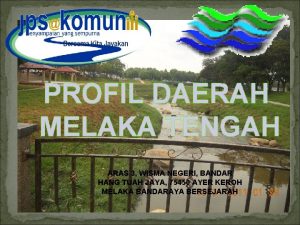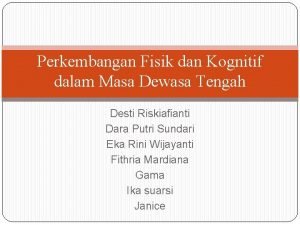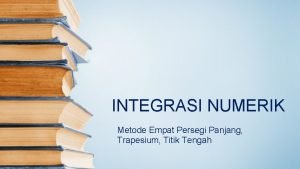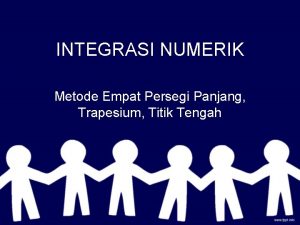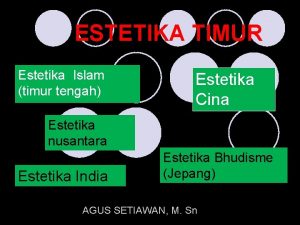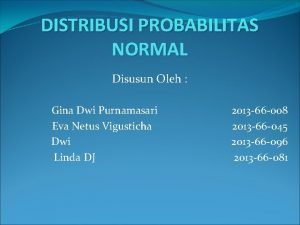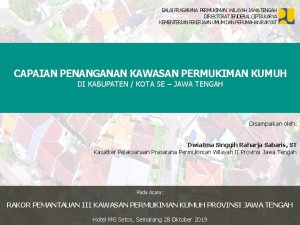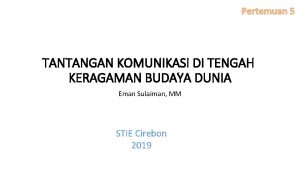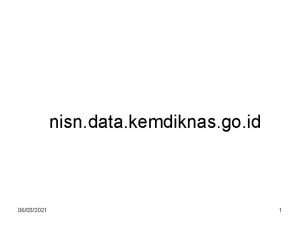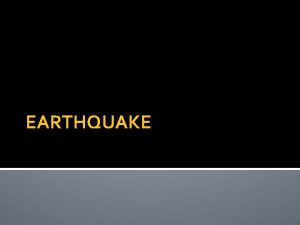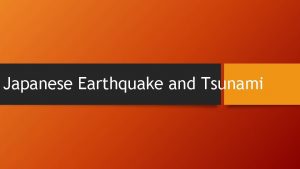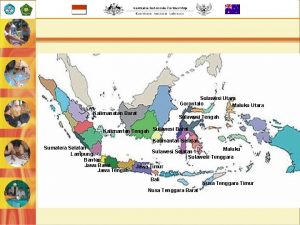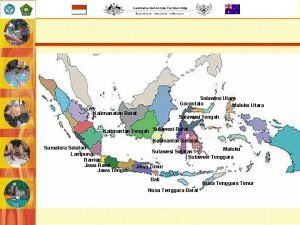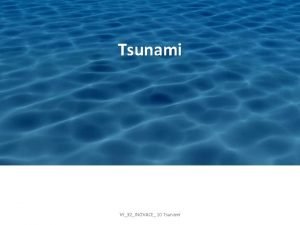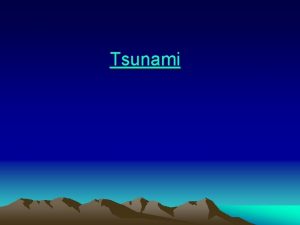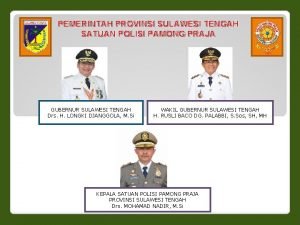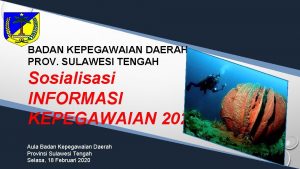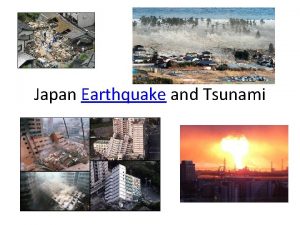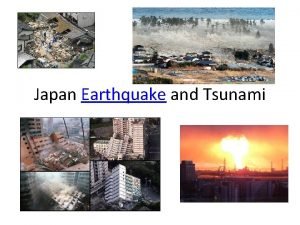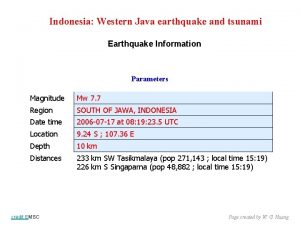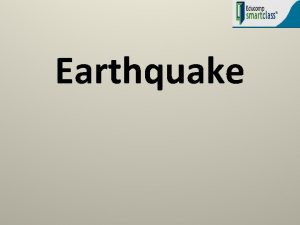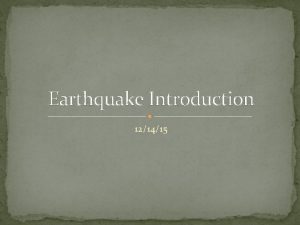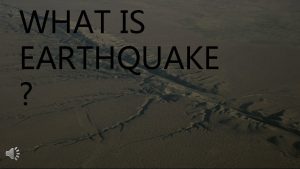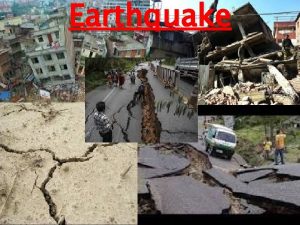Joint Need Assessment JNA Sulawesi Tengah Earthquake Tsunami






























- Slides: 30

Joint Need Assessment (JNA) Sulawesi Tengah Earthquake & Tsunami 28 Sep 2018 Report v. 1. 9 October 2018 Collaboration of Emergency Capacity Building consortium and Humanitarian Forum Indonesia and others Data live online: https: //bit. ly/2 Rn. Ud 7 x

Purpose JNA • Carried out rapid need assessment during initial days and weeks after 7. 4 RS Earthquake and Tsunami hit Central Suawesi (Donggala, Palu ad Sigi). • Understanding of the nature of the earthquake & Tsunami impact and priorities (basic need) of affected people through primary data collection. • Provide information that allow the strategic key decision that need to be made based on the JNA finding Method • Carried out key informant interview of male, female and mix group in displaced site (camp, informal IDPs center, public building, residing at side of original home, host family, staying at original home); Interviews – Man: 113; Women: 63; Groups Discussions – Man: 33 Groups Discussions – Women: 33 • Purposive random sampling, collation of secondary and primary data (before and after the earthquake)

Report • JNA report is to provides an initial understanding of the impact of the earthquake & Tsunami in Central Sulawesi, within the initial weeks which includes a component of primary data collection and people needs in their displaced site so that allow humanitarian organisation to do strategic key decision that need to be made based on respot finding. • Report will cover: In the initial weeks the JNA aims to: • Highlight priority geographic areas. • Identify priority sectors. • Identify how the lives of people have changed as a result of the disaster (impact). • Establish the general situation across affected areas

Time and Coverage JNA • JNA taken from the period of 3 – 8 October 2018 • Number of data taken (as of 8 October) 242 in below areas • Additional of other secondary data sources such as from Post command data and RNA (observation, interview and FGD) done by Yayasan PLAN combine into the repot. • Coverage areas: • 4 District (Palu, Donggala, Sigi and Parigi Moutong) • 29 Sub District • 107 Villages • Not all affected areas can covered/visited by JNA (Balaesang Tanjung – Pantai Barat Donggala due to the no access (difficult) • Places data taken (interviewed) • 101 in displaced site • 85 residing at side of original home • 13 formal IDPs center (managed by village/government) • 7 host family • 4 public building • 20 Others (independent camp/swadaya, moved to other save area) • 10 live in their house • 2 blank

SHELTER YES 17% Most of people are not living inside the house (83%) Most of the house visited are damaged (85. 48%) From the 242 sites visited, more than 67% people are still living in their village of origin and in their community. The rest moving to other places (host family, IDPs sites, other villages and event go to the neighborhood city). For IDPs site that are affected by tsunami and The people in the affected areas especially in Palu city are very individual and strong support per family/group/relative/race so the setting of the camps are grouping as it is and they are not sharing resources. Without a proper camps coordinator, the management in the camps become messy.

IDP’s Site situation There is no privacy to all affected sites IDP’s center. People, especially girls, young women, lactating and pregnant mothers. With only makeshift tent with limited matrass or no matrass at all, lack of blanket and other protection measures in the IDP camps make the situation become difficult especially for girls, adolescent and other people at risk (elderly, pregnant and lactating mother). Overcrowded tents, tent with small size with more than 10 people stays together, limited number of latrine (If it is available, it’s not separate for men and women and many IDP camps do have latrine at all), lack of water, no electricity at night, open space for shower/bathing which make the situation uncomfortable for the girls and women to go out and or do sanitation practice. They have to shower with full clothes and as most of them lost everything after the quake and tsunami, sometime they prefer not to take shower for days not only because lack of water but also due to privacy issue which put them in health risk which the level of concern on this subject between men and women; girls and boys are different, for men and boys they feel ok with that. (Qualitative observation by Yayasan PLAN, taken from 2 -4 Oct, 2018)

DISPLACEMENT POPULATION COMMAND POST DATA 8 OCT 2018 IDP’s DISTRICT TENTARA NASIONAL INDONESIA ANGKATAN DARAT # IDP’s # PEOPLE PALU 83 38, 621 SIGI 21 16, 200 DONGGALA 20 21, 223 TOTAL 75, 044 KOMANDO DAERAH MILITEXIII/MERDEKA POSKO PENGUNGSI NO I III Name IDPs Site # IDPs SEKTOR PALU BTN KORPRI KAWATUNA LAP. BOLA KAKI KAWATUNA LAP. PORDASI PETOBO 1, 000 2, 000 1, 500 1, 000 1, 500 2, 407 LAP. ANOA STADION GAWALISE BALAROA BTN PALUPI PARMAI YONIF 711/RKS LAP. VATULEMO MASJID AGUNG SEKTOR KAB. DONGGALA LOLI OGE (BANAWA) LOLI TASI BURI (BANAWA) TANJUNG KARANG GUNUNG BALE (KOPM BUPATI) LABUAN LELEA PESISIR BARAT SEKTOR KAB. SIGI JONO SIGI LOLU LORU Total 2, 000 1, 500 2, 000 1, 000 4, 000 27, 407 Most of sites visited has urgent needs on bedding materials (75. 1%)

House damage Among 4 districts visited, Sigi experienced the most heavily damaged on houses, 54%. Houses that heavily damaged in Donggala reached 36% and Palu 32%. While in Parigi Moutong, only 6% houses that heavily damaged. In areas visited, 191 locations, most of houses are permanent (concrete). In 136 locations, the houses are semi permanent (concrete and woods) and only 19 locations that are not permanent (woods).

WASH Most of sites visited have access to clean water (72. 2%). Only 27. 8% that do not have access to clean water; • Palu Selatan: Petobo • Palu Barat: Lere • Palu Timur: Lolu Selatan, Lolu Utara, Besusu Barat, Besusu Tengah • Palu Utara: Mamboro Barat, Taipa • Banawa: Gunung Bale, Labuan Bajo, Boya • Dolo: Potoya • Mantikulore: Poboya, Talise, Layana Indah • Marawola: Padende, Baliase • Parigi Selatan: Olobaru, Nambaru • Sigi Biromaru: Sidera, Jono Oge, Loru, Mpanau, Ngatabaru, Lolu, Soulowe, Pombewe • Sindue: Lero • Sindue Tombusabora: Tibo, Batasuya Go’o • Tanambulava: Sibalaya Utara • Tanantovea: Wani • Tatanga: Pengawu • Tawaeli: Lambara, Baiya • Ulujadi: Kabonena

WASH There are changes in source of water after disaster: • There is increase in consumption of bottled water • There is significant increase in accessing water from river • There is increase in accessing springs, and other sources of water • There is decrease in accessing water from PDAM piping and drilling well Notes: • There is still no water testing after disaster. • Difficulties in water access also caused by limited electricity so that community can not pump water from Drilling Well. Main water sources before and after the disaster.

WASH After disaster, in most of the sites (41. 42%) the task of collecting water is done by both male and female / young and old. While in 34. 3% sites, its done by male, 12. 62% sites its done by female, 8. 74% sites its done by boys, 2. 59% sites its done by girls.

WASH After disaster, there is significant increase in the numbers of female who can not access the sanitary napkin, from 12 to 168.

WASH There is decrease in the usage of private toilet both male and female. And there is increase in the usage of communal toilet. And after disaster, there are people who do not use toilet. They went to the river or other places.

HEALTH Related to medical personnel, in all sites visited, there are 72 sites that have midwives, 51 sites have doctor, 68 sites have nurse and the rest are not having any medical personnel. 63% from the visited sites said the health facilities was not functioning. While 37 % said still functioning but not like in normal situation. Update from the provincial health office at least in 122 IDP camps there already health services and 4 units health clinic in Palu city has been operated. In Sigi still under assessment. No info for Donggala yet. There is also health post at the airport to help screening the patient who need referral to Makasar hospital especially those who need urgent surgery (5 Oct 2018)

HEALTH Health facilities still function in area visited Among all sites visited, most of health facilities that still operating are; Puskesmas in 49 sites, followed by Poskesdes in 22 sites, Pustu in 12 sites, Polindes in 11 sites, hospital in 10 sites, Posyandu in 7 sites, other health facilities in 7 sites, and then Poliklinik in 2 sites and midwives in 2 sites.

HEALTH The tree most health concerns mentioned by people in visited areas are: Skin disease (81); Diarrhea (80) and Injured (77).

whether children's health is getting more HEALTH Is he children’s health condition getting worse? 53% confirmed yes. 151 of responsden said Food for children was also limited

HEALTH

INFORMATION In most of sites, main source of information is television (216 sites), then followed by hand phone (163 sites) and word of mouth information (151 sites).

INFORMATION Difficulties to access information is mostly caused by absence of electricity. Information sought by community mostly are information on emergency assistance services (140 sites) and medical assistance (139 sites). Other information which also mainly sought are information on security (83 sites) and missing people (82 sites).

INFORMATION The most significant needs identified is food (187 sites), then followed by temporary shelter (111 sites), toilet (106 sites), clean water (73 sites) and medical service (59 sites).

DISSABILITY There is 24. 9% sites visited that reported to have community members who still get trouble in seeing even though they already had glasses. There is 22. 82% of sites visited to have community members who needs assistive devices such as

DISSABILITY 26. 14% of sites visited has reported to have community members who get difficulties in walk up and down the stairs. 8. 71% of sites visited has reported to have community members who get difficulties in remember or concentrate.

DISSABILITY 23. 65% of sites visited has reported to have community members who get difficulties in selfcare, such as bathing, dressing or washing. In 8. 71% of sites visited has reported to have community members who have difficulty communicating, such as understanding or being understood by the other person, even though they already use everyday language / local area

FOOD SECURITY Please Note that the (U. N. World Food Program-WFP) staff visited some villages point from JNA on 11 October and mentioned: 1. The food priority need, looking at the date assessment taken (f 5 -6 Oct) and the field check (11 Oct) is down to the priority level 3 from level 2. This is because the villages already received food.

FOOD SECURITY Main reasons for decrease of food stocks: • Not enough food (48%) • High prices (15%) • No access to market (7%) • High oil prices (4%) • Others (26%) Others mentioned above varies from; no gasoline, no transport, market is not open.

MARKET Market is not functioning at least 7 days after the disaster, bank is closed, ATM is not operated due to no electricity. Livelihood were completely disrupt. Majority of people in the affected areas are civil servant, farmers and entrepreneurs. With the escalating of security incident most of the stores (minimarket) that sells basic needs have been looted. To be further assess through cash feasibility study.

EDUCATION Apakah ada penururan tingkat kehadiran siswa Tidak Ya • There is decrees of school attendance (88%) in areas visited. Most of the reason is because school are not open yet (no Teacher 103) and the school building are severe damaged. (75) and 60 said afraid to go to school. • at least there are 2, 376 schools with estimated 10, 000 teachers and 100, 000 school age girls and boys (no specific data per grade – primary, secondary and senior high school and by age group) (moe) • Schools are close until further notice. During the visit of President Jokowi on 3 October 2018 there is push to start the education activity by 13 October 2018.

PROTECTION - - Many girls and boys has indicate psychosocial distress including anxiety, some of them become moody (less talk, quite and other become hyperactive), routinely expressing worries, crying, displaying fearful reaction, clinging to a parents and not sleeping or less and some share stories that they lost their appetite and also admit sickness which again expose them to health risk. Meanwhile for adolescent girls (between 15 – 17 years old) in bigger IDP camps, there is a potential protection risk especially physical and sexual abuse especially at night because all camps still lack of electricity until now. NO SGBV case been reported, however it might be impacted due to no proper camps management as of now. In addition with many visitors in the camps from different background, some adolescent girls shows indication asking for “attention’ which expose them to potential risk of abuse, exploitation and trafficking. Vulnerable group after disaster are; Religious minority, children and widower and women headed family. Note that the horizontal conflict (religious) in this areas was high in the past.

MAP of SITES VISITED
 Did the nepal earthquake cause a tsunami
Did the nepal earthquake cause a tsunami Contoh lingkaran hukum adat di sumatera
Contoh lingkaran hukum adat di sumatera Suku yang terdapat di pulau sulawesi
Suku yang terdapat di pulau sulawesi Alat musik dari sulawesi utara
Alat musik dari sulawesi utara Ciri khas masakan sulawesi
Ciri khas masakan sulawesi Break joint lamb
Break joint lamb Luschka's joints
Luschka's joints Is a technique of making permanent joint
Is a technique of making permanent joint Joint venture accounting journal entries
Joint venture accounting journal entries Lamb grading chart
Lamb grading chart Condyloid joint
Condyloid joint Contoh pertanyaan training need analysis
Contoh pertanyaan training need analysis 3 market need
3 market need Angket need assessment bk
Angket need assessment bk Difference between eia and environmental audit
Difference between eia and environmental audit Ontario common assessment of need
Ontario common assessment of need Grades of mobilization
Grades of mobilization Joint assessment
Joint assessment Efile bkd prov jateng
Efile bkd prov jateng Rataan peubah acak
Rataan peubah acak Peta daerah melaka tengah
Peta daerah melaka tengah Perkembangan fisik dewasa madya
Perkembangan fisik dewasa madya Uji nilai tengah
Uji nilai tengah Pispk jawa tengah
Pispk jawa tengah Metode titik tengah
Metode titik tengah Kaidah titik tengah
Kaidah titik tengah Estetika timur tengah
Estetika timur tengah Harga saham di bej mempunyai nilai tengah 490 7
Harga saham di bej mempunyai nilai tengah 490 7 Balai prasarana permukiman wilayah jawa tengah
Balai prasarana permukiman wilayah jawa tengah Tantangan komunikasi di tengah keragaman budaya dunia
Tantangan komunikasi di tengah keragaman budaya dunia Bagian tengah navigator palette disebut…
Bagian tengah navigator palette disebut…
